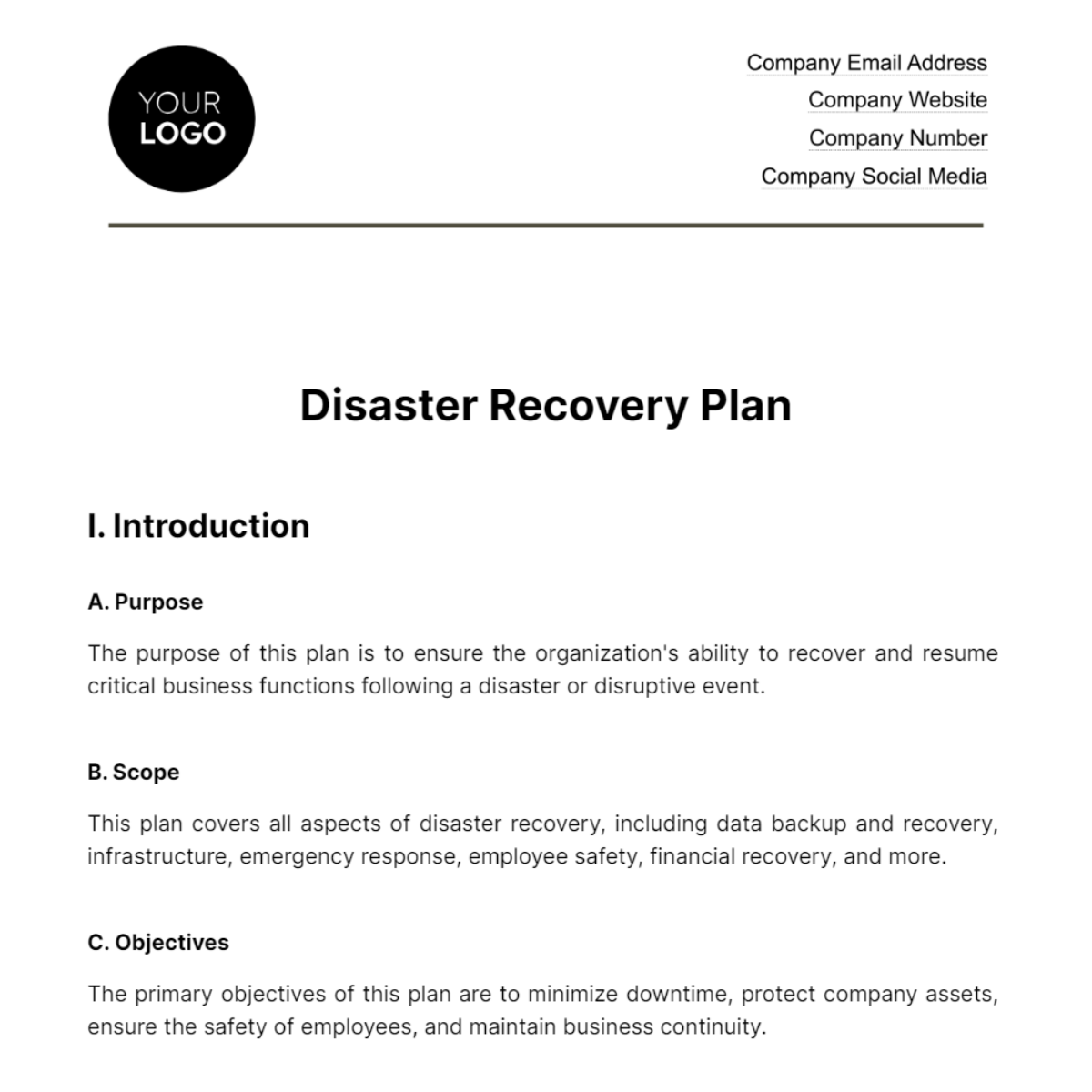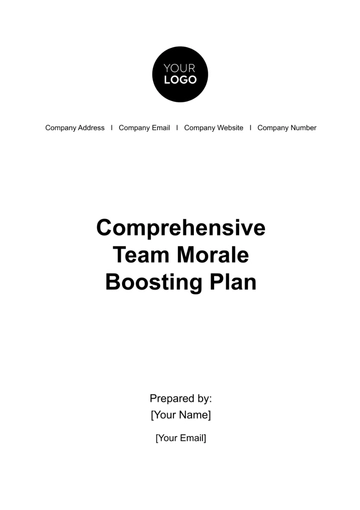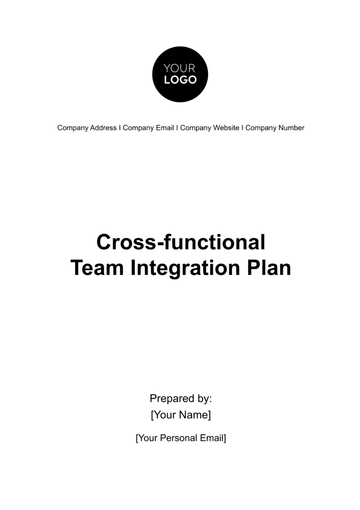Free Disaster Recovery Plan HR

I. Introduction
A. Purpose
The purpose of this plan is to ensure the organization's ability to recover and resume critical business functions following a disaster or disruptive event.
B. Scope
This plan covers all aspects of disaster recovery, including data backup and recovery, infrastructure, emergency response, employee safety, financial recovery, and more.
C. Objectives
The primary objectives of this plan are to minimize downtime, protect company assets, ensure the safety of employees, and maintain business continuity.
II. Roles and Responsibilities
A. Executive Management
Position | Task |
Chief Executive Officer (CEO) | Overall responsibility for the plan's execution and decision-making during a disaster. |
B. Disaster Recovery Team
Name | Position | Task |
Jessa Blake | Team Leader | Oversees the entire recovery process. |
III. Risk Assessment
A. Identifying Potential Risks
Natural disasters (e.g., earthquakes, floods)
Cyberattacks and data breaches
Fire and building damage
Supply chain disruptions
B. Impact Analysis
Potential loss of data
Financial losses
Operational downtime
Reputation damage
C. Risk Prioritization
Natural disasters ranked highest due to geographic location.
Cyberattacks and data breaches that are considered high risk.
IV. Data Backup and Recovery
We maintain a robust data backup strategy, encompassing automated daily backups to both on-site and off-site servers. These backups are subject to regular integrity checks and are the cornerstone of our data recovery procedures. In the event of a disaster or data loss, we follow a carefully outlined process to restore critical data, ensuring minimal downtime and maximum data integrity. Our commitment extends to frequent data restoration testing to guarantee our readiness for any unforeseen data-related challenges.
V. Infrastructure and Facilities
Our infrastructure resilience revolves around having designated backup facilities and a comprehensive inventory of equipment and resources. In the event of a facility-related disruption, we have secured alternate office space to ensure uninterrupted operations for our employees. Additionally, we maintain an up-to-date inventory of all IT hardware and software, which includes identifying spare equipment for swift replacement. In cases of communication disruption, we rely on satellite phones and mobile hotspots as backup communication methods to ensure continuity.
VI. Emergency Response
A. Communication Plan
Use the emergency notification system to alert employees.
Establish an emergency hotline for updates.
B. Evacuation Procedures
Designated evacuation routes and assembly points.
Evacuation drills conducted annually.
C. First Aid and Medical Assistance
First aid kits and trained personnel available on-site.
Local medical facility contacts for emergencies.
VII. IT Systems Recovery
A. Hardware Inventory
Detailed inventory of all servers, workstations, and networking equipment.
Identifying spare equipment for quick replacement.
B. Software Inventory
Comprehensive list of all software applications used.
Installation files and license keys stored securely.
C. Testing and Verification
Regular testing of system recovery procedures.
Independent audits to verify recovery capabilities.
VIII. Financial Recovery
A. Financial Records and Documentation
Secure off-site storage of financial records.
Access to financial information through cloud services.
B. Financial Recovery Strategies
Insurance coverage for property and business interruption.
Emergency access to financial resources.
C. Insurance Coverage
Comprehensive insurance coverage for all critical assets.
Regular review of policy terms and coverage limits.
IX. Training and Awareness
A. Employee Training
Annual disaster recovery training sessions.
Employee awareness campaigns on disaster preparedness.
B. Awareness Campaigns
Quarterly reminders and tips on disaster preparedness.
Employee newsletters with emergency information.
C. Drill and Exercise Schedule
Quarterly disaster recovery drills.
Annual full-scale disaster recovery exercise.
X. Conclusion
This plan represents our organization's commitment to resilience, preparedness, and the safeguarding of critical operations in the face of adversity. By outlining clear roles and responsibilities, assessing potential risks, and detailing comprehensive procedures for data recovery, infrastructure resilience, and emergency response, we have established a robust framework for addressing unforeseen disruptions. Our dedication to employee safety, financial recovery, ongoing training, and plan maintenance ensures that we are well-prepared to face and overcome challenges, protecting both our business and the well-being of our workforce. As we move forward, this plan will remain a dynamic and evolving resource, continuously adapted to the ever-changing landscape of potential threats and opportunities for improvement.
- 100% Customizable, free editor
- Access 1 Million+ Templates, photo’s & graphics
- Download or share as a template
- Click and replace photos, graphics, text, backgrounds
- Resize, crop, AI write & more
- Access advanced editor
Effective planning unlocked with Template.net's customizable Disaster Recovery Plan HR Template! This editable plan facilitates clear communication and actionable steps during disasters. Edit effortlessly with the AI Editor Tool, ensuring the plan aligns with your organization's disaster recovery policies. Get your flexible template for effective disaster planning by downloading today!
You may also like
- Finance Plan
- Construction Plan
- Sales Plan
- Development Plan
- Career Plan
- Budget Plan
- HR Plan
- Education Plan
- Transition Plan
- Work Plan
- Training Plan
- Communication Plan
- Operation Plan
- Health And Safety Plan
- Strategy Plan
- Professional Development Plan
- Advertising Plan
- Risk Management Plan
- Restaurant Plan
- School Plan
- Nursing Home Patient Care Plan
- Nursing Care Plan
- Plan Event
- Startup Plan
- Social Media Plan
- Staffing Plan
- Annual Plan
- Content Plan
- Payment Plan
- Implementation Plan
- Hotel Plan
- Workout Plan
- Accounting Plan
- Campaign Plan
- Essay Plan
- 30 60 90 Day Plan
- Research Plan
- Recruitment Plan
- 90 Day Plan
- Quarterly Plan
- Emergency Plan
- 5 Year Plan
- Gym Plan
- Personal Plan
- IT and Software Plan
- Treatment Plan
- Real Estate Plan
- Law Firm Plan
- Healthcare Plan
- Improvement Plan
- Media Plan
- 5 Year Business Plan
- Learning Plan
- Marketing Campaign Plan
- Travel Agency Plan
- Cleaning Services Plan
- Interior Design Plan
- Performance Plan
- PR Plan
- Birth Plan
- Life Plan
- SEO Plan
- Disaster Recovery Plan
- Continuity Plan
- Launch Plan
- Legal Plan
- Behavior Plan
- Performance Improvement Plan
- Salon Plan
- Security Plan
- Security Management Plan
- Employee Development Plan
- Quality Plan
- Service Improvement Plan
- Growth Plan
- Incident Response Plan
- Basketball Plan
- Emergency Action Plan
- Product Launch Plan
- Spa Plan
- Employee Training Plan
- Data Analysis Plan
- Employee Action Plan
- Territory Plan
- Audit Plan
- Classroom Plan
- Activity Plan
- Parenting Plan
- Care Plan
- Project Execution Plan
- Exercise Plan
- Internship Plan
- Software Development Plan
- Continuous Improvement Plan
- Leave Plan
- 90 Day Sales Plan
- Advertising Agency Plan
- Employee Transition Plan
- Smart Action Plan
- Workplace Safety Plan
- Behavior Change Plan
- Contingency Plan
- Continuity of Operations Plan
- Health Plan
- Quality Control Plan
- Self Plan
- Sports Development Plan
- Change Management Plan
- Ecommerce Plan
- Personal Financial Plan
- Process Improvement Plan
- 30-60-90 Day Sales Plan
- Crisis Management Plan
- Engagement Plan
- Execution Plan
- Pandemic Plan
- Quality Assurance Plan
- Service Continuity Plan
- Agile Project Plan
- Fundraising Plan
- Job Transition Plan
- Asset Maintenance Plan
- Maintenance Plan
- Software Test Plan
- Staff Training and Development Plan
- 3 Year Plan
- Brand Activation Plan
- Release Plan
- Resource Plan
- Risk Mitigation Plan
- Teacher Plan
- 30 60 90 Day Plan for New Manager
- Food Safety Plan
- Food Truck Plan
- Hiring Plan
- Quality Management Plan
- Wellness Plan
- Behavior Intervention Plan
- Bonus Plan
- Investment Plan
- Maternity Leave Plan
- Pandemic Response Plan
- Succession Planning
- Coaching Plan
- Configuration Management Plan
- Remote Work Plan
- Self Care Plan
- Teaching Plan
- 100-Day Plan
- HACCP Plan
- Student Plan
- Sustainability Plan
- 30 60 90 Day Plan for Interview
- Access Plan
- Site Specific Safety Plan





























